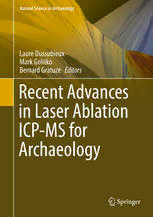Table Of ContentNatural Science in Archaeology
Laure Dussubieux
Mark Golitko
Bernard Gratuze E ditors
Recent Advances
in Laser Ablation
ICP-MS for
Archaeology
Natural Science in Archaeology
Series editors
G€untherA.Wagner
ChristopherE.Miller
HolgerSchutkowski
Moreinformationaboutthisseriesathttp://www.springer.com/series/3703
Laure Dussubieux (cid:129) Mark Golitko (cid:129)
Bernard Gratuze
Editors
Recent Advances in
Laser Ablation ICP-MS
for Archaeology
Editors
LaureDussubieux MarkGolitko
IntegrativeResearchCenter,Elemental DepartmentofAnthropology
AnalysisFacility UniversityofNotreDame
FieldMuseumofNaturalHistory NotreDame,IN,USA
Chicago,IL,USA
BernardGratuze
InstitutdeRecherchesurles
Arche´omate´riaux
CentreErnestBabelon
CNRS/Universite´d’Orle´ans
Orle´ans,France
ISSN1613-9712
NaturalScienceinArchaeology
ISBN978-3-662-49892-7 ISBN978-3-662-49894-1 (eBook)
DOI10.1007/978-3-662-49894-1
LibraryofCongressControlNumber:2016947426
#Springer-VerlagBerlinHeidelberg2016
Thisworkissubjecttocopyright.AllrightsarereservedbythePublisher,whetherthewholeor
part of the material is concerned, specifically the rights of translation, reprinting, reuse of
illustrations,recitation,broadcasting,reproductiononmicrofilmsorinanyotherphysicalway,
andtransmissionorinformationstorageandretrieval,electronicadaptation,computersoftware,
orbysimilarordissimilarmethodologynowknownorhereafterdeveloped.
Theuseofgeneraldescriptivenames,registerednames,trademarks,servicemarks,etc.inthis
publicationdoesnotimply,evenintheabsenceofaspecificstatement,thatsuchnamesare
exemptfromtherelevantprotectivelawsandregulationsandthereforefreeforgeneraluse.
Thepublisher,theauthorsandtheeditorsaresafetoassumethattheadviceandinformationin
thisbookarebelievedtobetrueandaccurateatthedateofpublication.Neitherthepublishernor
the authors or the editors give a warranty, express or implied, with respect to the material
containedhereinorforanyerrorsoromissionsthatmayhavebeenmade.
Printedonacid-freepaper
ThisSpringerimprintispublishedbySpringerNature
TheregisteredcompanyisSpringer-VerlagGmbHBerlinHeidelberg
Prologue
Sinceitsinceptionasamoderndiscipline,archaeologyhasstrivedtoproduce
morequantifiabledatatotestitstheoriesonhowhumancultureschangeand
transform.Oneparticularlyeffectiveapplicationforchartingthetransforma-
tionofobjectsofhumaningenuityorofhumanbeingsthemselveshasbeen
throughtheanalysisofthechemicalcompositionofmaterialculture.Irefer
tobothprovenancestudiesthatseektoidentifythegeologicalsourcemate-
rialofartifacts orecofacts andtochemicalcharacterizationstudiesfocused
on the alteration of a material through biological, environmental, or
manufacturingprocesses.Theformerincludeobsidiansourcing,claysourc-
ing,metallicoresourcing,orbiologicalsourcingthroughisotopicsignatures,
for example. The latter include applications such as identifying diagenic
processes on human bone, archaeochemical evidence for metallurgical
activities, or measuring heavy element contaminants in archaeobotanic
materials. Advances in technology in the twentieth century have propelled
theabilityofarchaeologiststomeasureandreportwithmuchgreaterpreci-
sion than ever before on these transformations, creating the discipline of
archaeometryintheprocess.
Technicaladvancesininstrumentationandtechniqueshavealwaysbeena
driverinarchaeometry.ThisiscertainlythecasewithLaserAblationInduc-
tivelyCoupledPlasma-MassSpectrometry(LA-ICP-MS).Sinceitsdevelop-
menttowardarchaeologicalapplicationsinthe1990s,LA-ICP-MShascome
intoitsownasoneofthepremierarchaeologicaltoolsfornearlynondestruc-
tive multielement compositional analysis of objects (Giussani et al. 2009;
Gratuzeetal.1993:Resanoetal.2010;SpeakmanandNeff2005).Itbuilds
onearlierhighresolutionmultielementtechniqueslikeInstrumentalNeutron
Activation Analysis (INAA), with the same multielement capabilities and
low detection limits in the parts per billion or, in the case of solution, parts
per trillion range. It has high throughput capabilities of tens of samples
processed per day, and unlike INAA, it does not produce dangerous long-
term radioactive waste. It is cost-effective and has minimal impact on the
objectofstudy.
LA-ICP-MS is not without its challenges, of course. Technique specific
issues include the stability of the instrument’s detector, accounting for
v
vi Prologue
doublychargedandoxidespecies,interferences,andlimitsofdetection(see
Pollard et al. 2007 for detailed descriptions of these problems). Issues with
replicability and reproducibility can create problems for quantitative analy-
sis,especiallyinheterogeneousmaterialswheredifficultyinmatrixmatching
betweenthesampleandstandardmayintroduceerrors.Likewise,theanaly-
sisproduceslargeamountsofdatathatmayhavevaryingdegreesofaccuracy
andprecisionacrosselementsandmatrices. Thedatamustbeevaluated for
quality,andunreliabledatamaybeomittedfromtheanalysis.Thereisaneed
forcuratinglargeamountsofdatalongtermandmakingthemaccessibleto
otherresearchers.
Despitethechallenges,LA-ICP-MShasbecomethemostwidelyutilized
high resolution technique for multielement characterization in twenty-first
century archaeology. Numerous university and museum labs dedicated to
archaeological applications of LA-ICP-MS have sprung into being, and
many other multidisciplinary labs are in existence. There are certain
advantages to having laboratories dedicated to archaeological LA-ICP-MS,
including specialized method development, prioritization of archaeological
sampling,andthedevelopmentofstaffwithtechnologicalknow-howaround
archaeologicalmaterials.OneexampleofsuchalabisTheFieldMuseum’s
Elemental Analysis Facility, founded in 2005. Equipped with a quadrupole
LA-ICP-MS,astandard213nmlaser,andanexperimentaladaptablecham-
ber266nmlaser,theEAFservesarchaeologistsandcollectionsfromaround
the world as well as the museum’s own vast archaeological collections
housed in the same building. Several of the chapters in this volume derive
fromEAF-basedresearch.
This volume highlights these advances in LA-ICP-MS applications in
archaeology, with reviews of how the technology works (Chap. 1) and
innovations in sample introduction including new adaptable laser cell and
profiling technologies (Chaps. 2–5). The latter chapters are dedicated to
exploring the application of the technique to a variety of material types,
from non-vitreous materials primarily of metallic origin (Chaps. 6–8) to
vitreous materials including glass and obsidian (Chaps. 9–14). The final
chapters explore the expansion of LA-ICP-MS to materials including
slag, garnet, stone, mineralized tissue, and lead glazes (Chaps. 15–19).
This work highlights the results of a 20-year history of Laser Ablation
ICP-MS in archaeology and its potential for future growth. Given the
state of the discipline, it is clear that LA-ICP-MS will continue to revolu-
tionize archaeology as the next generation of archaeologists takes it to new
frontiers.
IntegrativeResearchCenter,SocialSciences PatrickRyanWilliams
FieldMuseumofNaturalHistory
Chicago,IL,USA
Prologue vii
References
GiussaniB,MonticelliD,RampazziL(2009)Roleoflaserablation–inductivelycoupled
plasma–massspectrometryinculturalheritageresearch:areview.AnalChimActa
635:6–21
Gratuze B, Giovagnoli A, Barrandon J-N, Telouk P, Imbert J-L (1993) Apport de la
me´thode ICP-MS couple´e a` l’ablation laser pour la caracte´risation des
arche´omate´riaux.Revued’Arche´ome´trie17:89–104
Pollard M, Batt C, Stern B, Young SMM (2007) Analytical chemistry in archaeology.
CambridgeUniversityPress,Cambridge
Resano M, Garcia-Riuz E, Vanhaecke F (2010) Laser ablation – inductively coupled
plasmamassspectrometryinarchaeometricresearch.MassSpectromRev29:55–78
Speakman RJ, Neff H (eds) (2005) Laser ablation-ICP-MS in archaeological research.
UniversityofNewMexicoPress,Albuquerque,NM
ThiSisaFMBlankPage
Contents
1 Instrumentation,Fundamentals,andApplicationofLaser
Ablation-InductivelyCoupledPlasma-MassSpectrometry. . . . 1
MattiasB.FrickerandDetlefG€unther
PartI SampleIntroduction
2 IntroductiontoSolidSamplingStrategies. . . . . . . . . . . . . . . 23
MarkGolitko
3 Open-CellAblationofKillkeandInkaPotteryfrom
theCuzcoArea:MuseumCollectionsasRepositories
ofProvenienceInformation. . . . . . . . . . . . . . . . . . . . . . . . . . 27
MarkGolitko,NicolaSharratt,andPatrickRyanWilliams
4 Optimizationof2DLA-ICP-MSMappingofGlass
withDecorativeColoredFeatures:ApplicationtoAnalysis
ofaPolychromeVesselFragmentfromtheIronAge. . . . . . 53
JohannesT.vanElteren,SerenaPanighello,VidS.Sˇelih,
andEmilioF.Orsega
5 LA-ICP-MSAnalysisofAncientSilverCoinsUsing
ConcentrationProfiles. . . . . . . . . . . . . . . . . . . . . . . . . . . . . . 73
GuillaumeSarahandBernardGratuze
PartII ApplicationtoNon-siliceousMaterials
6 AnalysisofNon-siliceousArchaeologicalMaterialsby
LA-ICP-MS. . . . . . . . . . . . . . . . . . . . . . . . . . . . . . . . . . . . . . 91
LaureDussubieux
7 PreciseandAccurateAnalysisofGoldAlloys:Varna,
theEarliestGoldofMankind—ACaseStudy. . . . . . . . . . . . 95
VerenaLeusch,MichaelBrauns,andErnstPernicka
8 LA-ICP-MSAnalysisofPrehistoricCopperandBronze
MetalworkfromArmenia. . . . . . . . . . . . . . . . . . . . . . . . . . . 115
DavidL.Peterson,JohnV.Dudgeon,MonicaTromp,
andArsenBobokhyan
ix

